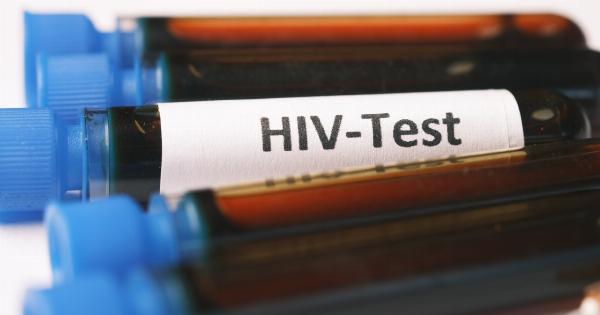Human Immunodeficiency Virus (HIV) is a virus that attacks the immune system, specifically the CD4 cells (T cells), which play a crucial role in protecting the body from infections and diseases.
Acquired Immunodeficiency Syndrome (AIDS) is the most advanced stage of HIV infection, where the immune system is severely damaged, making individuals highly susceptible to life-threatening infections and diseases.
How is HIV transmitted?
HIV can be transmitted through various means, including:.
Contact with infected blood: This can occur through sharing needles or other equipment used for injecting drugs, or through accidental exposure to infected blood in healthcare settings.
Unprotected sexual intercourse: HIV is most commonly spread through sexual contact with an infected person.
It can be transmitted through vaginal, anal, or oral sex, particularly if one of the partners has a high viral load (the amount of HIV in their blood).
From mother to child: HIV can be transmitted from an infected mother to her child during pregnancy, childbirth, or breastfeeding. However, with effective treatment and medical interventions, the risk of transmission can be significantly reduced.
Other body fluids: Although the risk is relatively low, HIV can also be transmitted through contact with other body fluids, such as semen, vaginal fluids, and breast milk.
This can occur when these fluids come into contact with open cuts or sores, or when they come into contact with mucous membranes, such as the lining of the vagina, rectum, or the opening of the penis.
Signs and symptoms of HIV
Many individuals infected with HIV may not experience any symptoms in the early stages of infection. However, some people may develop a flu-like illness, known as acute retroviral syndrome, within 2 to 4 weeks after the initial infection.
This illness may include symptoms such as fever, headache, fatigue, swollen lymph nodes, sore throat, skin rash, and muscle aches.
After the initial stage, HIV continues to replicate and progress to more advanced stages, often taking years before any severe symptoms appear. During this time, the virus can still be transmitted to others.
The symptoms of advanced HIV infection, or AIDS, are mainly a result of the weakened immune system and may include:.
Severe or recurrent infections: Individuals with AIDS may experience frequent infections that would not normally occur in individuals with a healthy immune system.
These can include pneumonia, tuberculosis, thrush (a fungal infection in the mouth or throat), and various opportunistic infections.
Rapid weight loss: AIDS can cause significant weight loss and wasting due to a variety of factors, including loss of appetite, inability to absorb nutrients, and chronic diarrhea.
Extreme fatigue: Many people with AIDS experience persistent fatigue, even with adequate rest and sleep.
Swollen lymph nodes: Lymph nodes, which play a crucial role in the immune response, may become enlarged due to HIV infection.
Neurological issues: HIV can affect the central nervous system, leading to problems with memory, concentration, and coordination. Seizures and mental health conditions, such as depression and anxiety, are also common.
Opportunistic cancers: People with AIDS have an increased risk of developing certain types of cancers, including Kaposi’s sarcoma, lymphomas, and cervical cancer (in women).
Diagnosing HIV
Early detection and diagnosis of HIV are crucial for prompt treatment and preventing further transmission. HIV can be diagnosed through blood tests that detect the presence of HIV antibodies or HIV genetic material.
It is important to note that it may take several weeks or months after initial infection for these tests to accurately detect the virus.
It is recommended that individuals who engage in behaviors with a higher risk of HIV transmission, such as unprotected sex or sharing needles, get tested regularly.
Additionally, pregnant women are routinely screened for HIV to prevent mother-to-child transmission.
Treatment and management of HIV and AIDS
While there is currently no cure for HIV, advances in medical science have enabled the development of highly effective antiretroviral therapy (ART) that helps control the virus and allows people with HIV to live long and healthy lives.
ART involves taking a combination of medications that target different stages of the HIV life cycle, thereby reducing the viral load in the body.
Adherence to ART is vital for its effectiveness. It is recommended to take medications as prescribed, without missing doses, to maintain an undetectable viral load.
Regular monitoring and follow-up with healthcare providers are essential to ensure the therapy is working effectively and to address any potential side effects.
In addition to ART, individuals with HIV and AIDS can also benefit from various supportive therapies and measures, including:.
Mental health support: Living with HIV can have significant emotional and psychological impacts. Access to mental health services, counseling, and support groups can be instrumental in managing the challenges associated with the condition.
Nutrition and dietary counseling: Good nutrition plays a crucial role in supporting the immune system and overall health.
Dietary counseling can help individuals make informed choices to maintain a balanced diet and manage any specific nutritional needs.
Prevention and education: Educating individuals about HIV transmission, safe sex practices, and harm reduction strategies is vital in preventing new infections.
Promoting HIV testing, condom use, and access to sterile needles for injecting drug users are important public health measures.
Preventing mother-to-child transmission: With appropriate interventions, the risk of transmission from an HIV-positive mother to her child can be significantly reduced.
Antiretroviral medications during pregnancy and breastfeeding, as well as formula feeding when necessary, can greatly minimize this risk.
Conclusion
HIV and AIDS continue to be significant global health challenges, but with advancements in treatment and prevention strategies, the outlook for individuals living with HIV has vastly improved.
Timely diagnosis, access to treatment, and supportive care are critical in managing the virus and preventing further transmission. Promoting awareness, reducing stigma, and ensuring equitable access to healthcare services are essential in the fight against HIV and AIDS.


























